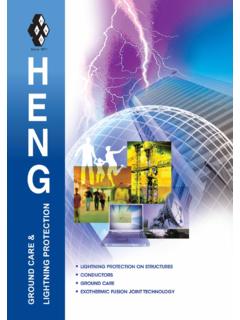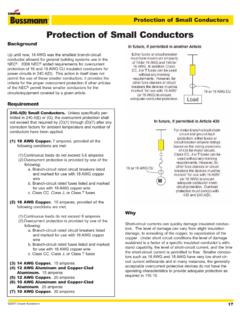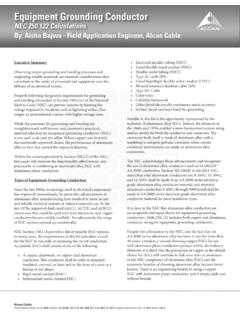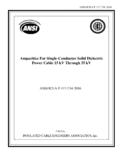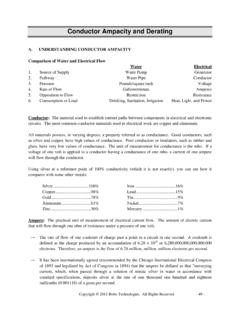Transcription of Fields of application of nickel plated copper …
1 Fields of application of nickel plated copper conductor By Selcuk Harput Sarkuysan Electrolytic copper Co. Turkey Abstract: Increasing experience in nickel coating techniques on copper wire has been an important factor encouraging its use in the form of cables for high temperature applications . Unfortunately, the expected amendments in related standards lagged behind, or simply neglected, are essential for correct material selection for cable producers and end users. To compare the properties of nickel plated copper wire to those of tin and silver plated copper wires and highlight the outstanding properties gained by nickel plating in regard to their high temperature applications are the aims of this paper.
2 The main topics taken under consideration are physical, electrical and thermal properties of nickel coated copper wire, its standard specifications and wire geometries, its comparison with other coating metals ( tin and silver) and giving information about special thermally resistant insulation materials, and the bases of selection for best wiring material under different environmental conditions at certain temperatures. Selcuk Harput is R&D Manager in Sarkuysan Electrolytic copper Co., Turkey. He is responsible for all research and development activities of Sarkuysan.
3 He joined Sarkuysan in 1988. He was previously primary aluminium production superintendent in Etibank Aluminum Plant, Turkey. He holds a diploma in metallurgical engineering from The Middle East Technical University, Ankara, Turkey. He is a member of WAI, AESF and Chamber of Metallurgical Engineers in Turkey. nickel plating: a short history nickel can be expressed as good high and low temperature strength, high oxidation resistance, corrosion resistant, highly desirable material. nickel was discovered in 1751 by Cronsted in Sweden. nickel and copper were electrochemically deposited after silver until 1830 s.
4 In 1840, Shore filed a patent for electrochemical nickel deposition, followed in 1842 by B ttger who actually plated nickel from a nickel ammonium sulphate solution. Around 1870, chloride and boric acid additions are described. There was not significant development between 1870 and 1940 from the electroplating point of view, except in 1916 when Watts developed his formulation which is still known as Watts bath . In the 1950 s, new acid baths started replacing the cyanide formulations thus improving safety. The years between 1870 and 1940 were rather tame.
5 Only one improvement can be mentioned. In 1916 Watts developed his formulation, still known as the Watts bath. This increased current densities tenfold, from to 5 Adm . In the 1950 s, new acid baths started replacing the cyanide formulations thus improving safety and increasing current densities up to 40 Adm . Part of wire and cable sector entered nickel plating area after the development of high speed electroplating processes. Because nickel plated wire and cable is an unrivalled material especially in high temperature corrosive applications . nickel plated wires It is estimated that over 10 000 tones of copper wire are plated worldwide per year with silver or nickel .
6 These plated wires are used principally for stranded conductors in high performance electric cable for the aerospace, airframe, defense, computer, telecommunication and professional electronics industrial sectors. In addition, plated wire is used for high temperature cable, spark ignition leads and fuses. nickel plated copper wires can resist temperatures up to 750 C. They are corrosion resistant and weld easily. Stranded conductors in this material are coated with suitable temperature resistant materials for cables. This coating process is requiring high temperatures, makes it unsuitable for silver plated wires which would oxidize.
7 A drawback with nickel plated copper is its reluctance to solder easily without special fluxes and the need to plate the nickel under carefully controlled conditions in order to give a pore - free and suitably ductile deposit for drawing. Parallel to the developments in nickel electroplating technology and exploring new insulating materials, silver plated wires left temperature dependent areas to nickel plated wires and cables. nickel plated copper cables are now an undoubted materials in aviation and aerospace industry. Because nickel plated wires can resist thermal shocks, continuous high temperature exposure and temporarily very high temperatures higher than the melting temperature of copper substrate.
8 Plating metals other than nickel over copper limit the working temperature of cable. But, in most cases the working temperature of nickel plated copper cables can only be limited by insulating materials. nickel plated copper wires are also used in other industrial applications than aviation and aerospace such as, iron, steel, aluminum, glass, petrochemical and pyrometallurgical plants. Basic Components of High-Temperature Insulated Wire As mentioned before, nickel plated high temperature cables are generally resistant to temperatures where insulation materials can.
9 In general, high temperature cables consist of five basic components which are conductor , insulation, protective braid, jacketing and shielding. Not all elements are appropriate for each construction. Simpler constructions may require only a conductor and extruded insulation. Usually, unprotected insulation is a tough thermoplastic or synthetic rubber with good electrical insulating ( dielectric) properties. When severe service is expected at elevated temperatures, more complex constructions may be required. Figure-1: Basic components of high-temperature insulated cables conductor Critical conductor selection variables are a composition of conductor material, conductor diameter and stranding.
10 Expected service temperature should be considered first because conductor materials vary in heat resistance. Next to be evaluated should be the conductor 's capacity to carry current without surpassing the temperature rating of the conductor and insulation. Material and conductor circular mil area are key determinants of this capacity. Finally, the decision should be made on how much flexibility is required, for this determines the stranding configuration. According to the standard ASTM B 355, nickel layer thicknesses have been classified as nickel percentages and nickel layer thickness as 1,27 (50 in) depending on the conductor diameter.
